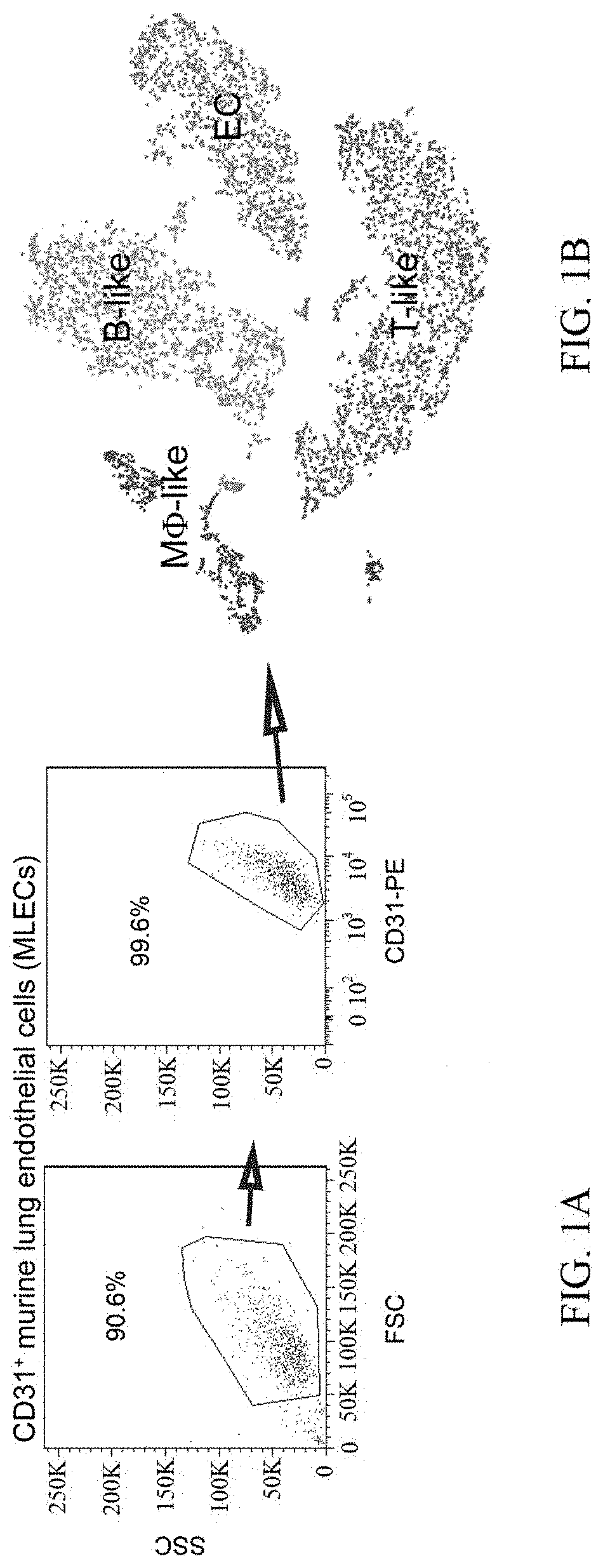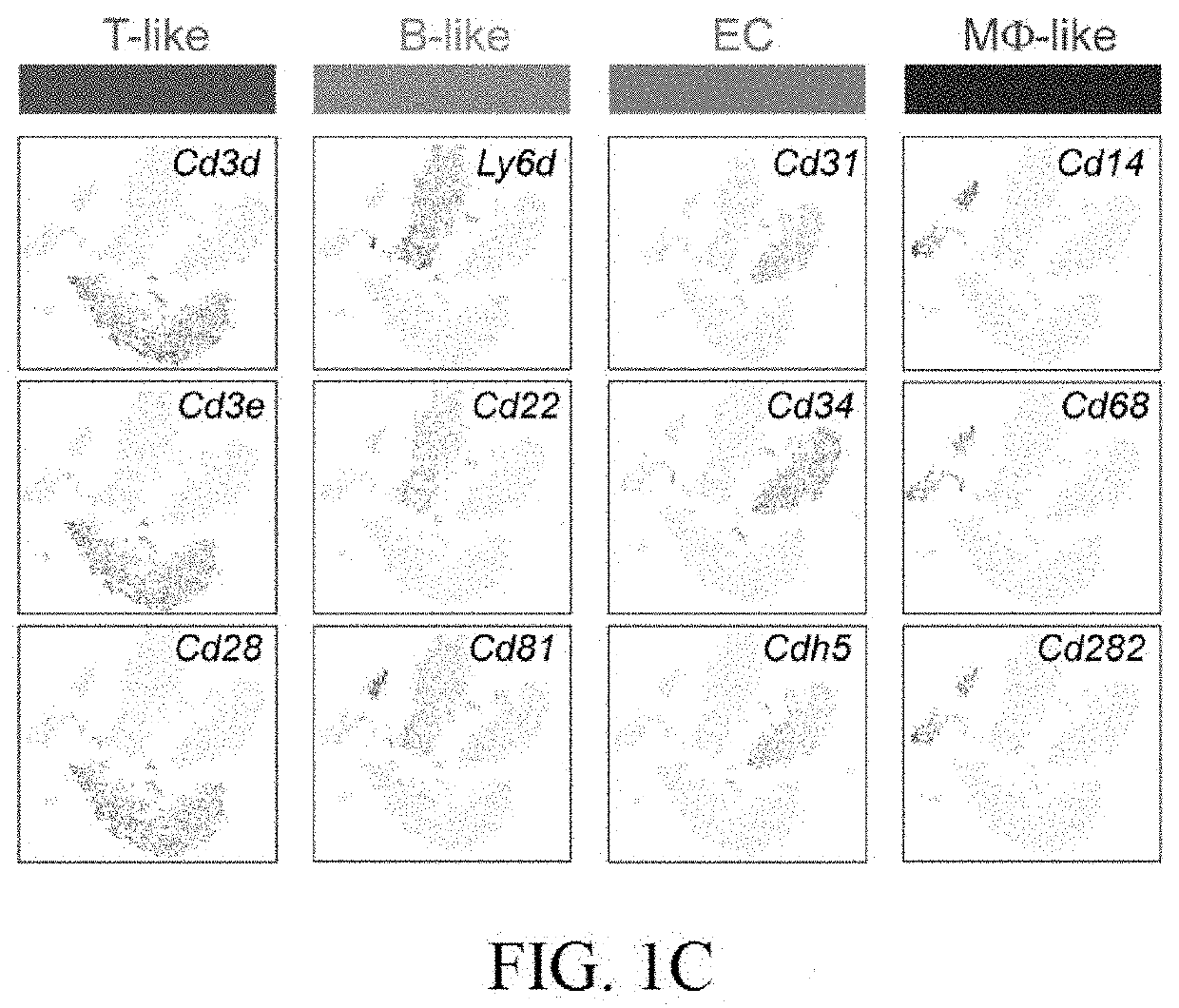Use of endothelial progenitor cells in rejuvenating the microvasculature, preventing aging and treating age-related diseases
- Summary
- Abstract
- Description
- Claims
- Application Information
AI Technical Summary
Benefits of technology
Problems solved by technology
Method used
Image
Examples
example 2
Progeroid ECs Exhibit a Systemic Inflammatory Response
[0069]Of the four clusters of CD31+ MLECs, ECs and Mφ-like cells showed high levels of p21Cip1 / Waf1 (FIG. 8A), a typical senescence marker. This finding suggests that these cells are the main target of progerin in the context of aging. Interestingly, a previous study reported that Mφ-specific progerin, achieved by crossing Lmnaf / + to Lyz-Cre mice, caused minimal aging phenotypes, implicating that Mφ might have only a minor role in organismal aging. We thus focused on ECs for further analysis. We recovered 899 and 445 ECs from E2A and Flox mice, respectively (FIG. 2A). Genes with >1.5-fold change in expression between these mice were chosen for GO and KEGG analysis. We observed a significant enrichment in the pathways that regulate chemotaxis, immune responses in Malaria and Chagas diseases, inflammatory bowel disease and rheumatoid arthritis and pathways essential for cardiac function (parts FIGS. 2B-D). To confirm this observati...
example 3
VE Dysfunction Promotes Vasodilation Defects in Progeria Mice
[0070]Our single-cell transcriptomic analysis in MLECs and quantitative PCR in HUVECs suggest that the VE have essential roles in systemic aging. To confirm these findings, we crossed the Lmnaf / f mice to a Tie2-Cre line, in which Cre recombinase expression is driven by the promoter / enhancer of endothelial-specific Tie2 gene, to generate Lmnaf / f; TC mice. Single-cell transcriptome analysis confirmed that Tie2 gene was mainly detected in ECs (FIG. 8B). Consistently, progerin was only observed in the VE of Lmnaf / f; TC but not Lmnaf / f control mice or other tissues (FIGS. 9A-B). VE-specific progerin induced intima-media thickening in Lmnaf / f; TC mice, in a similar manner as LmnaG609G / G609G mice (FIGS. 3A-B). We next performed a functional analysis of the VE based on acetylcholine (Ach)-regulated vasodilation. Ach-induced thoracic aorta relaxation was significantly compromised in Lmnaf / f; TC mice (FIG. 3C). Similar defects were ...
example 4
Progeria Mice Show Defective Neovascularization Following Ischemia
[0071]Reduced capillary density and neovascularization capacity are both characteristics of vascular aging. We thus examined the microvasculature in various tissues of Lmnaf / f; TC mice by immunofluorescence staining. We observed a significant loss in CD31+ ECs in Lmnaf / f; TC mice compared to controls (FIGS. 4A-B). We further examined ischemia-induced neovascularization ability in Lmnaf / f; TC mice following femoral artery ligation. Indeed, limb perfusion after ischemia was significantly blunted in Lmnaf / f; TC mice compared to controls (FIG. 4C). Histological analysis confirmed that the defect in blood-flow recovery in Lmnaf / f; TC mice was a reflection of an impaired ability to form new blood vessels in the ischemic region (FIG. 4D). Taken together, Lmnaf / f; TC mice are characterized by a loss of ECs, a reduced capillary density and defective neovascularization capacity.
PUM
 Login to View More
Login to View More Abstract
Description
Claims
Application Information
 Login to View More
Login to View More - R&D
- Intellectual Property
- Life Sciences
- Materials
- Tech Scout
- Unparalleled Data Quality
- Higher Quality Content
- 60% Fewer Hallucinations
Browse by: Latest US Patents, China's latest patents, Technical Efficacy Thesaurus, Application Domain, Technology Topic, Popular Technical Reports.
© 2025 PatSnap. All rights reserved.Legal|Privacy policy|Modern Slavery Act Transparency Statement|Sitemap|About US| Contact US: help@patsnap.com



